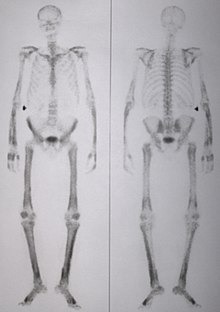Hypertrophic osteoarthropathy
Hypertrophic osteoarthropathy is a medical condition combining clubbing and periostitis of the small hand joints, especially the distal interphalangeal joints and the metacarpophalangeal joints. Distal expansion of the long bones as well as painful, swollen joints[3] and synovial villous proliferation are often seen. The condition may occur alone (primary), or it may be secondary to diseases like lung cancer. Among patients with lung cancer, it is most associated with adenocarcinoma and least associated with small cell lung cancer. These patients often get clubbing and increased bone deposition on long bones. Their presenting signs and symptoms are sometimes only clubbing and painful ankles.[citation needed]
| Hypertrophic osteoarthropathy | |
|---|---|
| Other names | Hypertrophic pulmonary osteoarthropathy, Bamberger–Marie syndrome,[1] osteoarthropathia hypertrophicans[2] |
 | |
| Bonescan of a person with hypertrophic osteoarthropathy | |
| Specialty | Rheumatology |
Cause
editHypertrophic osteoarthropathy is one of many distant effect disorders due to cancer, with lung cancer being the most common cause but also occurring with ovarian or adrenal malignancies. A distant effect disorder, or a paraneoplastic syndrome, affects distant areas and thus is not related to local compression or obstruction effects from the tumor. Other paraneoplastic syndromes include hypercalcemia, SIADH, Cushing's syndrome and a variety of neurological disorders.[citation needed] Thought to be due to fibrovascular proliferation caused by accumulation of megakaryocytes in the digital vessels which are normally filtered by the lungs.[citation needed]
Diagnosis
editPeople with hypertrophic osteoarthropathy may have bone scans showing parallel lines of activity along the cortex of the shafts and ends of tibiae, femurs and radii; especially around the knees, ankles and wrists. This activity may decrease after treatment of the underlying cause.[4]
Treatment
editNon-steroidal anti-inflammatory drugs (NSAIDs) can give significant relief of the symptoms. Treatment of lung cancer or other causes of hypertrophic osteoarthropathy results in regression of symptoms for some patients.[citation needed]
Etymology
editThe eponymous 'Bamberger–Marie syndrome' is named for Austrian internist Eugen von Bamberger and French neurologist Pierre Marie.[5][6][7]
See also
editReferences
edit- ^ Armstrong DJ, McCausland EM, Wright GD (February 2007). "Hypertrophic pulmonary osteoarthropathy (HPOA) (Pierre Marie-Bamberger syndrome): two cases presenting as acute inflammatory arthritis. Description and review of the literature". Rheumatol. Int. 27 (4): 399–402. doi:10.1007/s00296-006-0224-2. PMID 17006703. S2CID 21226683.
- ^ Deller A, Heuer B, Wiedeck H (December 1998). "Is myositis ossificans following ARDS a complication of prone-dependency or is it osteoarthropathia hypertrophicans (Bamberger-Marie syndrome)?". Intensive Care Med. 24 (12): 1345–6. doi:10.1007/s001340050776. PMID 9885895. S2CID 34009164. Archived from the original on 1999-08-23.
- ^ Goldman, Lee (2011). Goldman's Cecil Medicine (24th ed.). Philadelphia: Elsevier Saunders. p. 1196. ISBN 978-1437727883.
- ^ Essentials of Nuclear Medicine Imaging (Sixth Edition), 2012
- ^ synd/1756 at Who Named It?
- ^ von Bamberger E (1889). "Veränderungen der Röhrenknochen bei Bronchiektasie". Wiener klinische Wochenschrift. 2: 226.
- ^ Marie P (1890). "De l'osteo-arthropathie hypertrophiante pneumique". Rév Med, Paris. 10: 1–36.